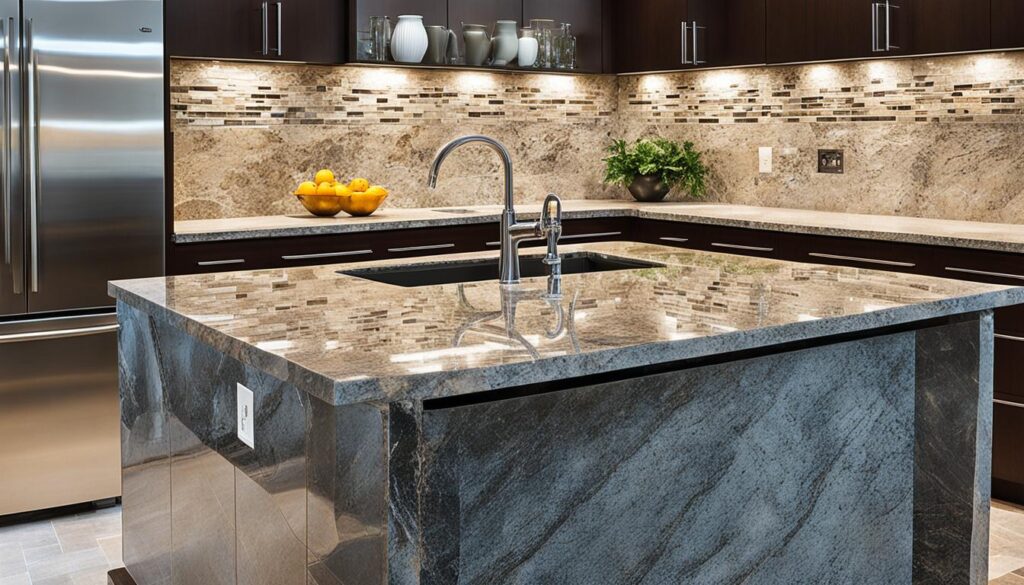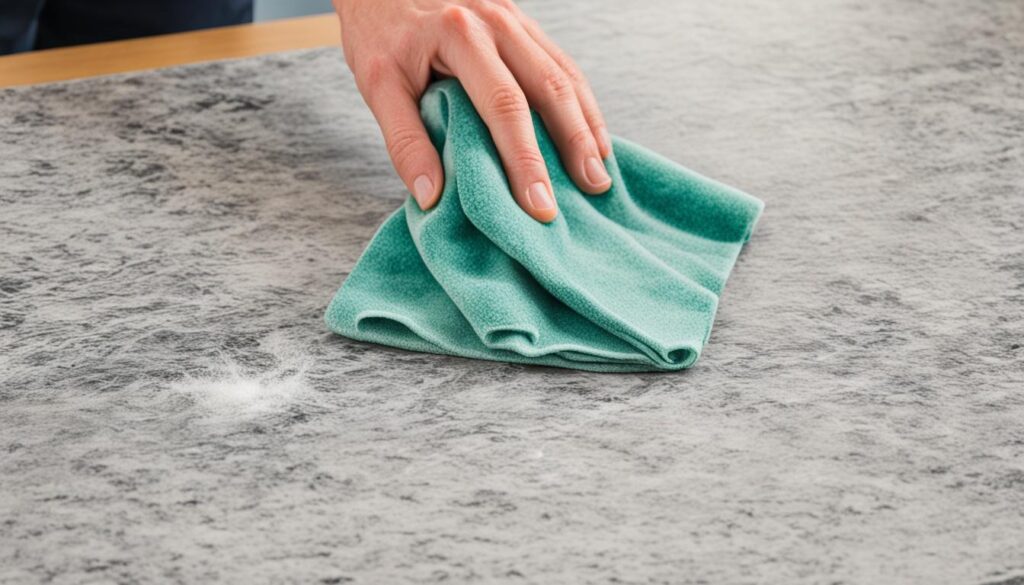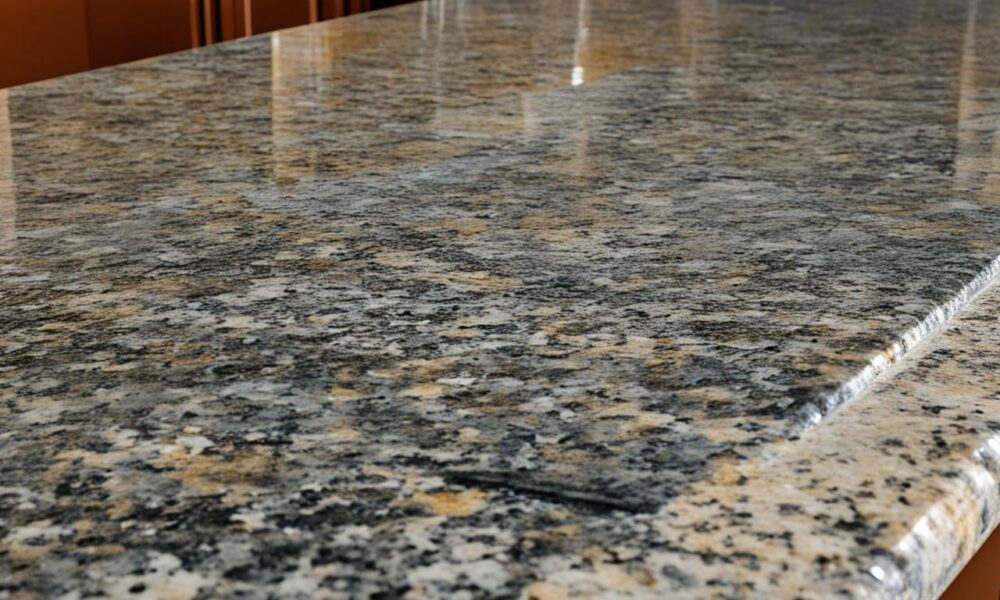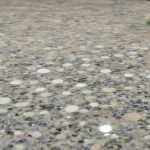Natural Stone Care: Cleaning and Sealing Best Practices
Natural stone makes any space look beautiful and lasts a long time. It’s great for kitchen countertops and stone floors. But, to keep it looking great, you need to clean and seal it right. Knowing how to care for your granite countertops, marble floors, or other stones is key.
Natural stone comes from three main types: sedimentary, metamorphic, and igneous. Some stones, like limestone and marble, are made of calcium carbonate and don’t like acidic cleaners. Others, like granite and quartzite, are made of silicates and can handle kitchen acids better.
Not all stones need sealing, but many do to fight stains. Clean your stone with mild cleaners and dry spills fast. If you have tough stains or need help, talk to a stone expert to keep your stone looking good.
Key Takeaways
- Understand the geological classification and composition of your natural stone to determine the best care practices.
- Use mild, non-acidic cleaners for calcareous stones like marble and limestone to avoid etching.
- Apply impregnating sealers to enhance stain resistance, especially for porous stones.
- Address spills promptly and use appropriate cleaning methods for different types of stains.
- Consult professionals for tough stains, etching, scratches, or other maintenance issues to ensure proper care.
Understanding Your Natural Stone’s Characteristics
To take good care of your natural stone surfaces, it’s key to know their unique traits. Natural stone comes in three main types based on how it was made: sedimentary, metamorphic, and igneous. Each type looks different and needs different care.
Geological Classifications: Sedimentary, Metamorphic, and Igneous
Sedimentary stones, like limestone and travertine, are made from mineral or organic bits that get pressed together. They can soak up liquids and need sealing to stop stains. Use gentle cleaners that won’t harm the stone.
Metamorphic stones, like marble and slate, change from other rocks under heat and pressure. They’re denser and last longer than sedimentary stones. To keep slate looking great, seal it and clean it right.
Igneous stones, such as granite and basalt, come from magma or lava that cools down. They’re very tough against scratches and stains. But, they still need the right care to stay shiny.
Calcareous vs. Siliceous Stones
Stones can also be calcareous or siliceous. Calcareous stones, like limestone and travertine, are mostly calcium carbonate and don’t like acidic cleaners. To fix travertine, polish it and fill in any gaps.
Siliceous stones, such as granite and slate, are mostly silicates and resist acids well. But, they can get damaged by harsh cleaners or wrong care.
| Stone Type | Geological Classification | Composition |
|---|---|---|
| Limestone | Sedimentary | Calcareous |
| Travertine | Sedimentary | Calcareous |
| Marble | Metamorphic | Calcareous |
| Slate | Metamorphic | Siliceous |
| Granite | Igneous | Siliceous |
Knowing about your stone’s type helps you pick the right cleaners, protectors, and fixers. This way, your stone will look great for many years.
Easy Care Tips for Preserving Natural Stone Beauty
Keeping your natural stone surfaces looking great is easy with the right care. Follow these simple tips to keep your granite, marble, limestone, and other stones looking new for years. This will help you enjoy their beauty and durability.
Using Coasters, Trivets, and Mats
Using coasters under glasses with alcohol or citrus can protect your stone from stains. For hot dishes, always use trivets or mats to prevent damage. This simple step helps keep your countertops and tables looking perfect.
Proper Dusting and Vacuuming Techniques
It’s important to dust and vacuum your natural stone regularly. Use a clean, dry dust mop for floors and mats or rugs at entrances to keep out dirt. Make sure vacuum attachments and wheels won’t scratch your stone.
Proper dusting and vacuuming keep your stone clean and extend its life. They prevent scratches and damage.
Addressing Spills Promptly
Accidents can happen, but act fast to protect your stone from stains. Blot spills with a clean paper towel, then clean with water and mild soap. Dry well to remove all residue.
Avoid wiping spills to prevent spreading them and causing stains. Use cleaners made for quartz or soapstone to keep them looking great. Quickly cleaning spills keeps your stone beautiful and stain-free.
Effective Cleaning Methods for Natural Stone
Keeping natural stone surfaces looking great requires the right cleaning methods and products. Whether it’s granite countertops, marble floors, or travertine tiles, knowing how to clean them is key. We’ll cover the best ways to clean natural stone, including choosing the right cleaners and drying techniques.

Choosing the Right Cleaners
When picking cleaners for natural stone, think about the stone’s porosity and how it handles scratches and stains. The finish and where the stone is used also matter. Always go for cleaners made for natural stone that are pH-neutral. They’re gentle and won’t harm the stone. Stay away from cleaners that are acidic or abrasive as they can damage the stone.
For green options, look for cleaners with certifications for air and water quality. These cleaners are usually water-based, free from harsh chemicals, and can break down easily. They help keep your space green and safe.
Applying Cleaning Solutions Correctly
Once you’ve picked the right cleaner, apply it right. Always follow the instructions for how much cleaner to use to avoid residue or streaks. Mix a little cleaner with warm water and clean with a soft cloth or mop. Don’t use too much water to avoid damage.
For outdoor stone, use a mild detergent and skip abrasive tools. In wet areas, like showers, use a squeegee to dry the surface and stop mineral buildup. Dusting often and cleaning spills right away keeps your stone looking good.
Rinsing and Drying Techniques
Rinse the stone well after cleaning to get rid of any leftover cleaner. Use clean water and change it often to avoid spreading dirt or cleaner. For floors, use a clean rag mop for even coverage and no streaks.
When cleaning countertops, use a soft cloth for the solution and debris. Rinse and dry the surface with a clean cloth to avoid water marks and streaks. Proper rinsing and drying keep your stone surfaces shiny and clear.
By cleaning your natural stone right and using the right products, your stone will stay beautiful for a long time. Regular care, including stone floor maintenance and sealing granite countertops, protects your investment and keeps your stone looking great.
| Stone Type | Cleaning Tips |
|---|---|
| Granite | Use a pH-neutral cleaner, avoid acidic or abrasive products, seal regularly |
| Marble | Clean with a mild, non-abrasive cleaner, dry immediately to prevent water spots |
| Travertine | Use a stone-specific cleaner, avoid acidic products, seal to prevent staining |
| Limestone | Clean with a pH-neutral cleaner, dry thoroughly to prevent etching |
Handling Specific Stains on Natural Stone Surfaces
Dealing with stains on natural stones like marble, limestone, or travertine is crucial. You need to know the stain type to pick the right cleaner. Different stains need different cleaning methods to keep the stone looking great.
Identifying the Type of Stain
First, figure out what kind of stain you’re dealing with. Common types include:
- Oil-based stains: These come from grease, tar, cooking oil, and makeup and make the stone darker.
- Organic stains: Drinks like coffee, tea, and wine can turn the stone pinkish-brown.
- Metallic stains: These look like orange, brown, green, or muddy-brown and follow the shape of the metal that caused them.
- Biological stains: Algae, mildew, and lichens can be cleaned with a mix of ammonia, bleach, or hydrogen peroxide.
- Ink stains: Use bleach, hydrogen peroxide, lacquer thinner, or acetone to clean these.
- Paint stains: For small paint spots, try lacquer thinner or a razor blade. For big areas, you might need a commercial paint stripper.
Oil-Based, Organic, and Biological Stains
For oil-based stains, use household cleaners like detergent, mineral spirits, or acetone. Organic stains from things like coffee or urine can be cleaned with 12% hydrogen peroxide and a bit of ammonia. Biological stains from algae can be removed with a mix of ammonia, bleach, or hydrogen peroxide and water.
A study by the National Center for Preservation Technology and Training (NCPTT) found that preparing natural stone surfaces well can make sealants work better by up to 40%. This shows how important cleaning is before sealing to get good results.
Metallic, Ink, and Paint Stains
Metal stains from things like iron or copper need special cleaners. Ink stains can be cleaned with bleach, hydrogen peroxide, lacquer thinner, or acetone, depending on the stone’s color. Paint stains can be removed with lacquer thinner or a razor blade for small spots, or a commercial paint stripper for big areas.
Always test any cleaner on a small, hidden spot first to make sure it won’t harm the stone. Using the right marble polishing techniques, limestone cleaning solutions, and travertine restoration methods keeps your natural stone looking great.
When to Seal Natural Stone Surfaces
Sealing is key to keeping natural stone surfaces looking great and lasting long. The type of stone affects how often you need to seal it. It’s a simple and affordable step that makes your stone last longer. Knowing when to seal your stone is important for keeping it in top shape.
The porosity of the stone tells you how often to seal it. Stones like marble, onyx, and limestone need sealing every six months. This keeps them looking good and protects against stains and damage. Stones like granite and quartz are less porous and only need sealing once a year.
| Stone Type | Sealing Frequency |
|---|---|
| Marble | Every 6 months |
| Onyx | Every 6 months |
| Limestone | Every 6 months |
| Granite | Annually |
| Quartz | Annually |
New countertops and backsplashes often come sealed, but you should know when to reapply the sealant. There are different types of sealants, like surface, penetrating, and impregnating. Surface sealants are water-based and good for tile floors. Penetrating sealants are solvent-based and offer long-lasting protection but can be hard to remove. Impregnating sealants are also solvent-based and last several years, perfect for outdoor stone because they resist UV damage and keep the stone looking good.
A simple test to see if your stone needs resealing is to leave a drop of water on the surface for 10-15 minutes. If the water soaks in, it’s time to reseal.
Even with a sealant, cleaning spills right away is key to avoiding stains. Floors in busy areas might need more frequent resealing. But, engineered stone like quartz and porcelain doesn’t need resealing because it’s very low porosity.
Regular care, like using gentle cleaners and protecting the stone from heat and scratches, helps your sealant last longer. Checking the sealer for wear and reapplying as needed keeps your natural stone looking great. If you’re unsure, ask professionals for advice on choosing and applying sealers, especially for quartz and soapstone.
Choosing the Right Sealer for Your Natural Stone
Choosing the right sealer is key to protecting your natural stone surfaces. The right sealer boosts the beauty of your marble, granite, travertine, or limestone. It also keeps stains and moisture away. With many sealers out there, knowing their unique traits and how they work with your stone is crucial.
Impregnating Sealers
Impregnating sealers go deep into your stone’s pores, creating a barrier against stains and moisture. They’re great for most natural stones, keeping their look while protecting them for a long time. These sealers don’t change how slippery a surface is, so they’re good for areas where oily foods and liquids might spill.
For granite countertops, remember that these sealers don’t stop etching from acidic things like wine or soft drinks on marble or limestone. Also, they’re not breathable and shouldn’t be used where moisture is expected, as it could harm the stone.
Enhancing Sealers
Enhancing sealers protect and make your stone look better. They’re perfect for stones with a honed or textured finish, highlighting their natural beauty. Always test these sealers on a small, hidden spot first to make sure you like the look.
If you’re thinking about enhancing sealers for your marble, know they might need to be reapplied more often than others. Keeping up with maintenance and checking the seal regularly is key to keeping your stone looking great.
Topical Sealers
Topical sealers put a protective layer on your stone’s surface, giving it a glossy or satin finish. They’re used to make the stone look better and more polished. But, they can scratch or peel over time and might need to be reapplied more often than other types.
When picking a topical sealer for your limestone, think about how much upkeep your stone needs. Not all stones are good with topical sealers, so make sure to check with a pro or do your homework before applying it.
| Sealer Type | Protection Level | Appearance | Reapplication Frequency |
|---|---|---|---|
| Impregnating Sealer | High | Natural | Low |
| Enhancing Sealer | Moderate | Enhanced color and depth | Moderate |
| Topical Sealer | Moderate to High | Glossy or satin finish | High |
The right sealer depends on your stone type, how much protection you need, and what you want it to look like. Always test the sealer on a small, hidden spot before applying it everywhere. Choosing the right sealer for your stone’s needs helps keep it looking and working well for many years.
Proper Application Techniques for Sealers
Using the right sealer is key to keeping your natural stone surfaces looking great and lasting long. Whether you have slate tiles, travertine, or quartz, applying a sealer correctly is crucial. Before you start, check your stone for porosity and damage. This helps you focus on areas that need extra care.
To get your stone ready for sealing, clean it with a pH-neutral cleaner mixed with three parts water. This solution removes dirt without harming the stone. Don’t use harsh cleaners like bleach or vinegar, as they can damage your stone. Let the surface dry fully before you seal it.
When picking a sealer, think about how much protection you need, the look you want, and your stone’s nature. Impregnating or penetrating sealers are usually best as they protect against stains and moisture without changing the stone’s look. Experts often suggest using a fluoropolymer-based sealer for the best protection. StoneTech Professional Impregnator Pro™ is a top choice for new stone.
To apply the sealer, use a clean cloth, brush, or sprayer, following the instructions. Make sure to cover the whole surface, especially porous areas. Some sealers need more than one coat for full protection. But don’t put on too much sealer, as it can make the surface look bad.
After applying the sealer, remove any extra and let the surface dry as directed. This drying is important for the sealer to bond well with the stone. This gives your stone long-lasting protection against stains and damage.
“Proper application techniques are essential for achieving the best results when sealing natural stone surfaces. By following these guidelines and using high-quality products, you can keep your slate tiles, travertine, and quartz surfaces looking beautiful for years to come.” – John Smith, Natural Stone Care Expert
| Natural Stone Type | Recommended Sealer | Application Method |
|---|---|---|
| Slate Tiles | Impregnating Sealer | Brush or Sprayer |
| Travertine | Enhancing Sealer | Clean Cloth |
| Quartz Surfaces | Fluoropolymer-based Sealer | Sprayer |
If you’re not sure about the best sealer or how to apply it, ask professionals or experts in natural stone care. They can help you choose the right products and methods for your stone’s protection.
Natural Stone Care: Cleaning and Sealing Best Practices
To keep your natural stone looking great, you need a good cleaning routine and to deep clean and reseal it now and then. By doing this, your stone floors, countertops, and other surfaces will stay in top shape for many years.
Establishing a Regular Cleaning Routine
For the best look, make a regular cleaning plan. Use a cleaner that’s pH-neutral, stone soap, or a mild dish soap mix with warm water. Don’t use cleaners with lemon or vinegar on calcareous stones as they can dull them. Always rinse well and dry with a soft cloth to avoid water spots. For more tips, check out Stone Floor Maintenance.
Periodic Deep Cleaning and Resealing
Regular cleaning isn’t enough; you also need to deep clean and reseal your stone now and then. How often depends on the stone type, where it’s located, and how much use it gets. For deep cleaning, use a poultice or a stone cleaner to get rid of tough stains. Then, apply a good sealer to protect it from future stains and damage. Always follow the sealer’s instructions and pick one right for your stone.
Proper stone sealing is key for keeping granite countertops shiny and durable.
Addressing Etches, Scratches, and Nicks
Even with the best care, your stone can get etched, scratched, or nicked. Etches from acidic things can be fixed with a special remover or by a pro. For scratches and nicks, use sandpaper or steel wool to smooth them out. But if they’re deep, you might need a pro to fix them.
| Stone Type | Recommended Cleaner | Sealing Frequency |
|---|---|---|
| Granite | pH-neutral cleaner or stone soap | Every 1-2 years |
| Marble | Mild liquid dishwashing detergent | Every 6-12 months |
| Soapstone | Soapstone Cleaner Recommendations | Every 6-12 months |
Follow these tips for caring for natural stone and use the right cleaners and sealers. This will help keep your stone looking great for years. Remember, clean regularly, deep clean and reseal when needed, and fix any damage quickly to keep your stone in top condition.
Avoiding Common Mistakes in Natural Stone Care
Keeping your natural stone surfaces looking great requires avoiding common mistakes. These mistakes can damage or mar the beauty of your stone. By learning the right care techniques and avoiding harmful practices, you can keep your marble, limestone, slate, and other stones looking new for years.

Using Acidic or Abrasive Cleaners
Many homeowners make the mistake of using cleaners that are too harsh. Things like vinegar or bleach can etch or burn the stone’s surface. This leaves behind marks or dulls the finish. Always use cleaners made for natural stone that are pH-neutral. These cleaners clean well without harming your stone.
Neglecting to Seal Porous Stones
Not sealing stones like limestone, travertine, and sandstone is another mistake. Without sealing, these stones can stain easily from spills and wear. Experts say to seal these stones every three to five years to keep them durable and stain-resistant. To see if your stone needs resealing, try the water drop test. If the water beads up and stays on the surface, the sealer is working well. If it soaks in, it’s time to reapply.
Applying Sealers Incorrectly
Even with the best intentions, applying sealers wrong can lead to a bad finish. Over-applying or not letting it dry long enough can cause problems. Always follow the instructions for applying and drying the sealer. If unsure, get advice from a professional stone care expert who knows the best way to seal your stone.
By avoiding these common mistakes and using the right care methods, you can keep your natural stone looking great for years.
| Stone Type | Common Mistakes | Best Practices |
|---|---|---|
| Marble | Using acidic cleaners, neglecting to seal | Use pH-neutral cleaners, seal every 3-5 months |
| Limestone | Scrubbing with abrasive pads, not sealing regularly | Clean with soft cloths, seal every 3-5 months |
| Slate | Using harsh chemicals, applying sealers incorrectly | Opt for gentle cleaners, follow sealer instructions carefully |
Knowing the best care for your natural stone surfaces and avoiding these mistakes will help you enjoy your marble, limestone, slate, and other stones for many years.
Conclusion
Caring for your natural stone surfaces means cleaning regularly, removing stains quickly, and sealing them now and then. Knowing what your stone is like, like marble, granite, limestone, or slate, helps you clean and seal it right. Use cleaners that are pH-neutral and don’t use harsh or acidic stuff that can hurt the stone.
For Stone Floor Maintenance, clean often with soft cloths or mops. Clean spills right away to stop stains.
Sealing your granite countertops is key to keeping them safe from stains and easy to clean. But not all stones need sealing, so check with a pro to see what your stone needs. When you do seal, follow the directions and make sure you cover the stone well for the best protection. Also, use coasters, trivets, and mats to keep your stone safe from scratches and damage from acidic things or heavy items.
If your stone gets etched, scratched, or nicked, fix it fast to stop more harm. For big cleanings or repairs, get help from a stone restoration expert. By cleaning and sealing right and keeping up with care, your natural stone will look great and last long, making your home more beautiful and valuable.



